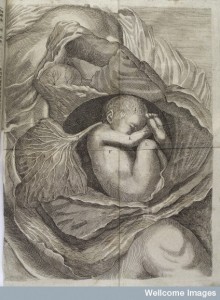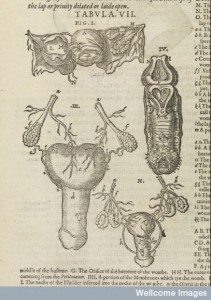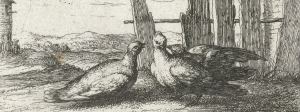 In his 1615 medical treatise Mikrokosmographia Helkiah Crooke wrote about the alarming possibility that women might be able to conceive without engaging in sexual activity. He explained that some other authors claimed that the ejaculation of the male seed into the womb wasn’t always required for conception to occur. This was supported by the ‘Tale of a woman who conceiued the seede of a man floating in the water of a bath, so strong sayeth hee was the attractiue faculty of the wombe in drawing of seede.’1 Without having sex this woman’s greedy womb sucked up and retained any male semen it came across resulting in pregnancy.
In his 1615 medical treatise Mikrokosmographia Helkiah Crooke wrote about the alarming possibility that women might be able to conceive without engaging in sexual activity. He explained that some other authors claimed that the ejaculation of the male seed into the womb wasn’t always required for conception to occur. This was supported by the ‘Tale of a woman who conceiued the seede of a man floating in the water of a bath, so strong sayeth hee was the attractiue faculty of the wombe in drawing of seede.’1 Without having sex this woman’s greedy womb sucked up and retained any male semen it came across resulting in pregnancy.
Crooke was clearly not impressed by this argument or scholars who believed in such scurrilous things. He lamented that ‘it is great wonder that a Philosopher would be so credulous to beleeve the excuse of a light-skirts, who to save her honesty devised this excuse’. He was impressed by the woman’s wit but not by her honesty. He clearly believed that such stories were invented in order to cover up the indiscretions of women who had acted as they shouldn’t.2
The suggestion that women could conceive without engaging in sexual activity may seem bizarre to a modern audience, but it came out of the medical uncertainty about whether or not sex was necessary for conception. One treatise on chemical medicine for example noted that ‘we see many Plants grow without precedent seeds, and many Animals produced without copulation of Male with Female’.3 In particular it was noted that fish could generate without recourse to copulation, which suggested that sex was not always necessary.
For much of the period medical men also argued about what men and women added to the new foetus, who formed and shaped it and who contributed the most to the process of generation. Medical writers could thus state that either men or women were more important to conception and generation, and influenced the form and nature of the new child the most.
The main component of generation that medical authors argued about was ‘seed’. Seed was the element responsible for creating a new conception. It was thought to be refined out of the blood, which in turn had been concocted out of the food. According to Isbrand van Diemerbroeck, seed was composed primarily of the subtle and salt particles of the blood along with animal spirits, other authors also argued that seed contained vital spirits.4 Animal spirits were the agent responsible for movement and sensation and were created in the brain before being dispersed through the body. Vital spirits were the immaterial force which gave life and animated bodies. Salt, as Diemerbroeck stated, caused the seed to be titillating and provoked sexual desire, encouraging men and women to engage in sexual activity and produce progeny.
Some medical writers followed the Aristotelian model which outlined that only men produced seed. This model was appealing as it allowed medical writers to confidently state the vital role of men in the process of conception and gestation. According to this framework the male seed, the active principle in generation, it shaped and formed the woman’s menstrual blood into the new foetus. Here then women did not possess everything necessary to form a foetus on their own and so the male role in generation was assured.
 However, many authors followed the Galenic and Hippocratic precept that both men and women produced seed. This was evident, they suggested, in the fact that both men and women had testicles (as this image from Crooke demonstrated). As God crested nothing in vain it was patent that women’s testicles must also produce seed: ‘Nature endevoureth nothing rashly or in vaine. If therefore there bee all the Organes for generating, boyling, and deriving or leading seede to the parts of generation in Women as in men, it must needs follow that they also do generate, boyle and leade downe seede’.5
However, many authors followed the Galenic and Hippocratic precept that both men and women produced seed. This was evident, they suggested, in the fact that both men and women had testicles (as this image from Crooke demonstrated). As God crested nothing in vain it was patent that women’s testicles must also produce seed: ‘Nature endevoureth nothing rashly or in vaine. If therefore there bee all the Organes for generating, boyling, and deriving or leading seede to the parts of generation in Women as in men, it must needs follow that they also do generate, boyle and leade downe seede’.5
The idea that women also produced seed allowed for the troubling possibility that women could have children without any male involvement. Along with seed, they produced menstrual blood which nourished the child through gestation allowing it to grow, and they had wombs in which this process could happen. Alexander Ross argued in favour of the Aristotelian model by explaining that this possibility meant the two-seed model just couldn’t be true: ‘because if the females seed were active, she may conceive of her self without the help of the male, seeing she hath an active and passive principle, to wit, seed and bloud; and where these principles are, there will be action and passion.’6 This was very troubling indeed as it suggested that men could be obsolete in this process, which did not fit with patriarchal ideas about the importance of men.
In order to appease these concerns much of the discussion about seed and generation focused on the relative importance of the male contribution. Although men only contributed seed, while women provided seed, blood and the womb, medical writers following the two-seed model often asserted that it was the masculine element that was vital. It was the active force that sparked a new life, and imparted a soul to the newly forming child. Thus medical writers were able to debate the relative contributions of men and women to generation, while maintaining the -man’s pre-eminent role in the process. As Diemerbroeck explained ‘Now that it [women’s seed] is not endu’d with a forming Power, appears from hence, that a woman cannot conceive of herself without the help of male Copulation.’7
_______________________________
1. Helkiah Crooke, Mikrokosmosgraphia … (London, 1615)
2.Ibid.
3. L. C. Fundamenta Chymica … (London, 1658), p.9.
4. Isbrand van Diemerbroeck, The Anatomy of Human Bodies, Comprehending the Most Modern Discoveries and Curiosities in that Art … (London, 1689), p. 136.
5. Crooke, p. 283.
6. Alexander Ross, Arcana Microcosmi, or the hid secrets of man’s body … (London, 1652), p. 28.
7. Diemerbroeck, p.204.
© Copyright Jennifer Evans all rights reserved
